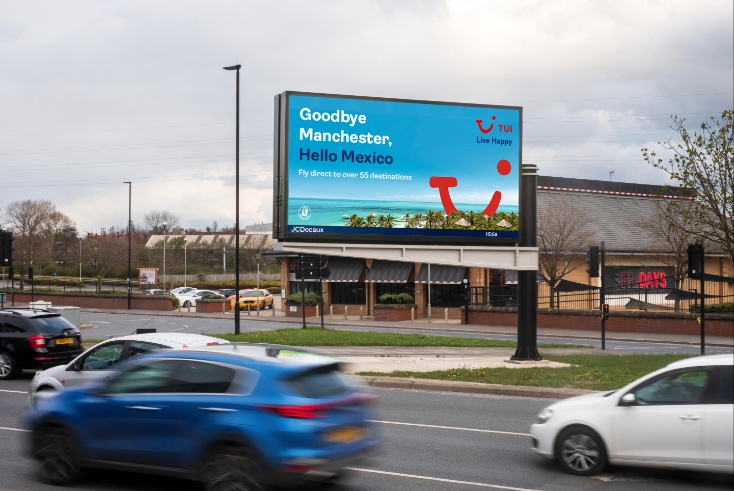Roadside OOH ads are concentrated in areas with lower disposable income in England and Wales, according to new research.
A study from campaigning group Adfree Cities analysed 83,672 roadside ad locations in the Great Britain (from Route Q1 2023 data), including classic and digital sites, and mapped this on to Indices of Multiple Deprivation (2019) published by the government, net annual income data after housing from the Office for National Statistics and air pollution data from the Department of Environment, Food & Rural Affairs.
This excluded outdoor sites in shopping centres, supermarkets, airports, motorway service stations, inside train stations and on buses or trains.
The report, Unavoidable Impact: How Outdoor Advertising Placement Relates to Health and Wealth Inequalities, by researcher Peter Brooks, found 82% of sites in the study were located in the poorest half of England and Wales.
Across England, there were more than six times as many outdoor sites in “the most deprived areas of the country” compared with “the least deprived areas”, at 12,687 sites versus 2,000.
In addition, 92% of the sites analysed were located in the half of England and Wales with the worst levels of particulate pollution.
Analysis: OOH can play positive role
Tim Lumb, director of OOH advertising trade body Outsmart, told The Media Leader that the report was missing “key points”.
“It doesn’t grasp the fundamental nature of OOH advertising, which is about reaching people when they are out and on the move commuting, shopping, seeing friends and leisure activities,” he said. “On average, this is over three hours a day. Audiences are not static and change by time of day, day of week, location and environment.
“Similarly, it shouldn’t be surprising that there are more OOH panels in cities than in less populated areas. Regarding the societal metrics and mapping of panels, the study fails to show any link between the two, except by vague and unsubstantiated implication.
Furthermore, advertising can play a role in supporting consumers in their current challenges, Lumb argued.
He continued: “My general view is there’s a cost-of-living crisis and we all know that disproportionately hits people who are on low incomes. Reducing that impact, reducing inequalities and social deprivation is a massive, massive task and a very complicated issue.
“What advertising does is it generates economic growth, which improves living standards overall. And OOH advertising directly helps councils because we provide funding for them through revenue, share agreements, rates, rents.
“And we provide public services because we build and maintain bus shelters, defibrillators, free telephone kiosks, free Wi-Fi, community messaging — all of that.”
Public good
Lumb also emphasised that OOH can be used to make the public aware of better, healthier choices as well as the support and initiatives available. Examples cited include placing MMR vaccine ads where measles cases are high and charitable executions offering help with school uniforms or food banks.
Importantly, Lumb added, outdoor ads not only meet Advertising Standards Authority guidance — some of the “strictest” in the world — but also Outsmart’s own policies, which, for instance, restrict ads for foods high in fat, sugar and salt, alcohol, vapes, gambling and lotteries near schools.
The UK OOH industry dedicated just under half of its £411m advertising revenue to public services, infrastructure, communities and employees in 2021, according to most recent figures from Outsmart and PwC.
Nearly half of UK OOH ad revenues ‘reinvested’ in public infrastructure
‘Environmental injustice’
Robbie Gillett, Adfree Cities’ spokesperson, told The Media Leader that “the true cost of the impacts” caused by OOH advertising have not been accounted for, such as social care and NHS costs from obesity as a result of junk food advertising or rising air pollution resulting from the advertising of high-carbon products.
Gillett described Adfree Cities as a network of residents “concerned about the impact of outdoor advertising” on mental health, wellbeing and the environment, as well as OOH’s effect on public spaces, particularly large digital screens.
The first of those groups, AdBlock Bristol, observed that wealthier areas in the city seemingly did not have the same amount of outdoor advertising as lower-income communities.
Gillett said the purpose of the research was to find out if that hypothesis held true across the country — something that he maintained the study showed, as demonstrated by case studies in Leeds and Sheffield.
Ad sites were “disproportionately located in the lower-income areas” of those cities because they were close to busy roads, according to Gillett, and that advertisers and outdoor media owners “actively champion” the presence of traffic and congestion because of higher dwell times.
Gillett added: “My point of doing this research is to say that it’s not OK. It’s environmental injustice that not only do communities living in areas like mine have to put up with the noise pollution and the air pollution from busy roads, but we also get the billboards placed in there as well.”
Reforms put forward
The Adfree Cities research made three recommendations.
The first recommendation is to reform planning legislation to expand the grounds for objection based on the wider impact on local communities, particularly around harms caused by digital billboards.
The second is for councils to “adopt a presumption against new advertising sites and digital screens” to prevent further disparity between high- and low-income communities.
Finally, the report recommended introducing a national ad ban for content promoting products that were “most damaging to public health”, compounded existing health inequalities and/or were harmful to the environment.
Adwanted UK is the trusted delivery partner for three essential services which deliver accountability, standardisation, and audience data for the out-of-home industry.
Playout is Outsmart’s new system to centralise and standardise playout reporting data across all outdoor media owners in the UK.
SPACE is the industry’s comprehensive inventory database delivered through a collaboration between IPAO and Outsmart.
The RouteAPI is a SaaS solution which delivers the ooh industry’s audience data quickly and simply into clients’ systems.
Contact us for more information on SPACE, J-ET, Audiotrack or our data engines.





